Abstract
Patients with porphyrias have varying degrees of photosensitivity, associated with elevated levels of porphyrins in plasma, erythrocyte, urine and/or feces. To investigate the role of complement in the pathogenesis of cutaneous lesions, varying amounts of uroporphyrin were added to normal human serum (0.1-10 microgram/ml), and the mixtures were then exposed to 405 nm irradiation. Such treatments result in the diminution of total hemolytic complement activity and hemolytic titers of C1, C4, C2, C3, and C5; furthermore, cleavage products of C3 and C5 were detected. Chemotactic activity for human polymorphonuclear leukocytes was generated that was inhibitable by incubation with anti-C5, but not with anti-C3 antisera. No chemotactic activity was generated in Mg++-EGTA treated serum nor in C4-deficient guinea pig serum. These data indicate that irradiation with 405 nm light of normal human serum containing uroporphyrin results in activation of the complement system via the classical pathway, and the generation of complement (C5)-derived chemotactic activity for human polymorphonuclear leukocytes.
Full text
PDF
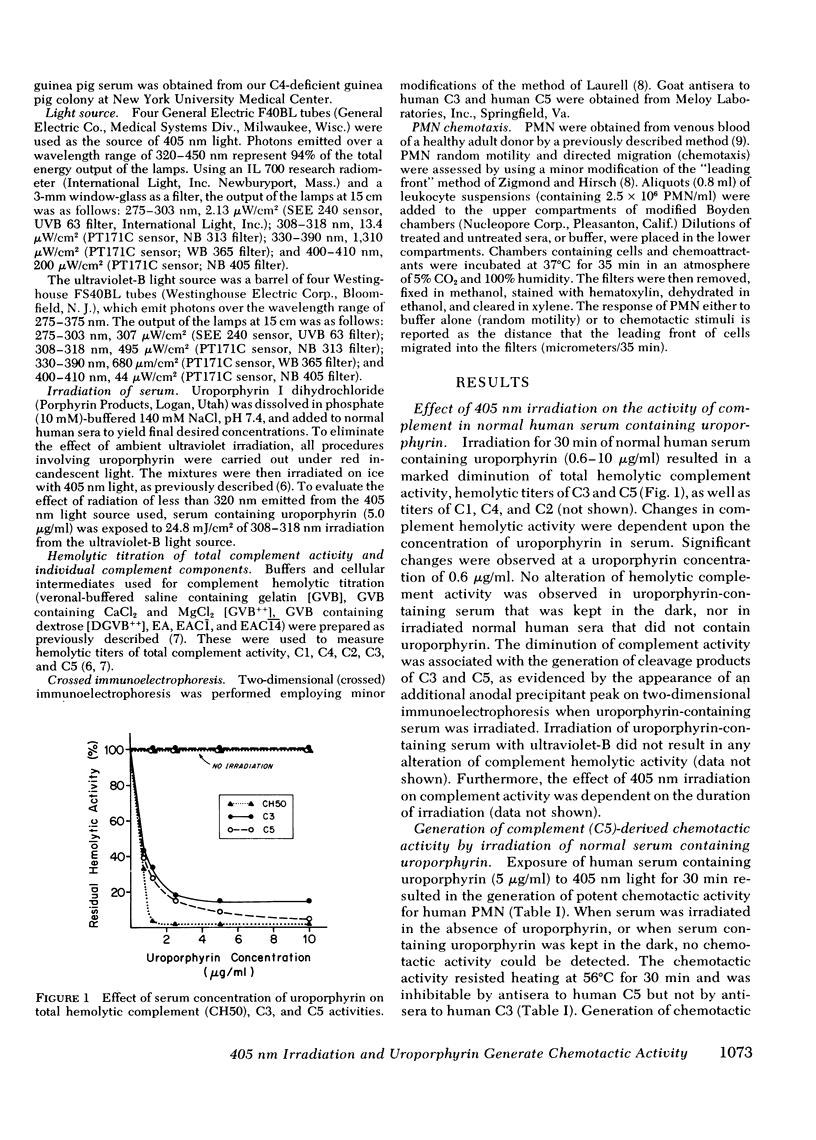
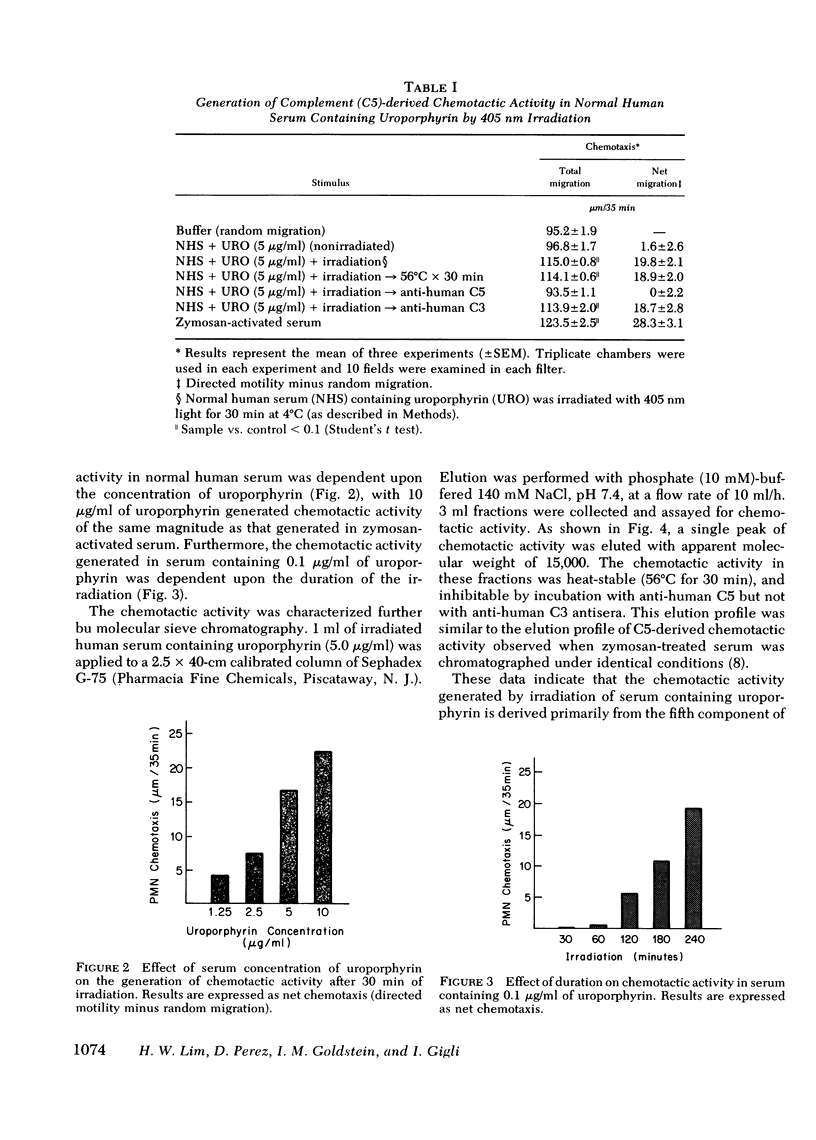
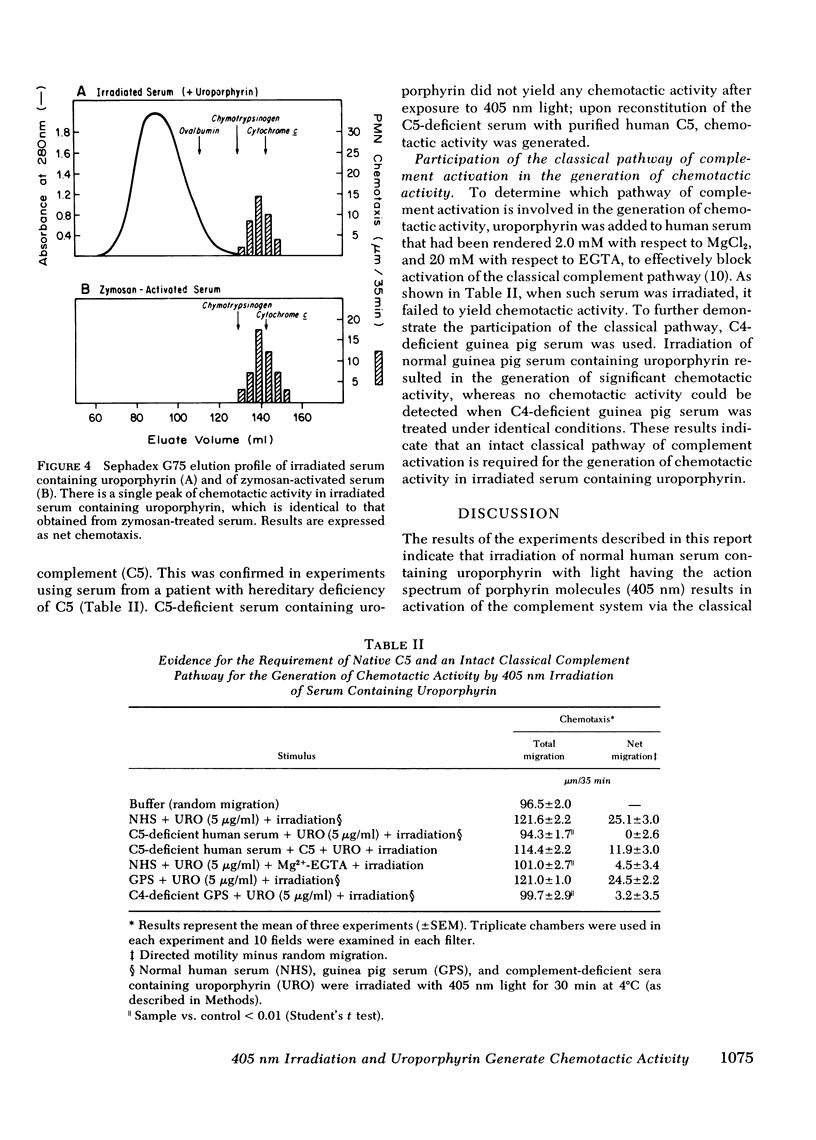
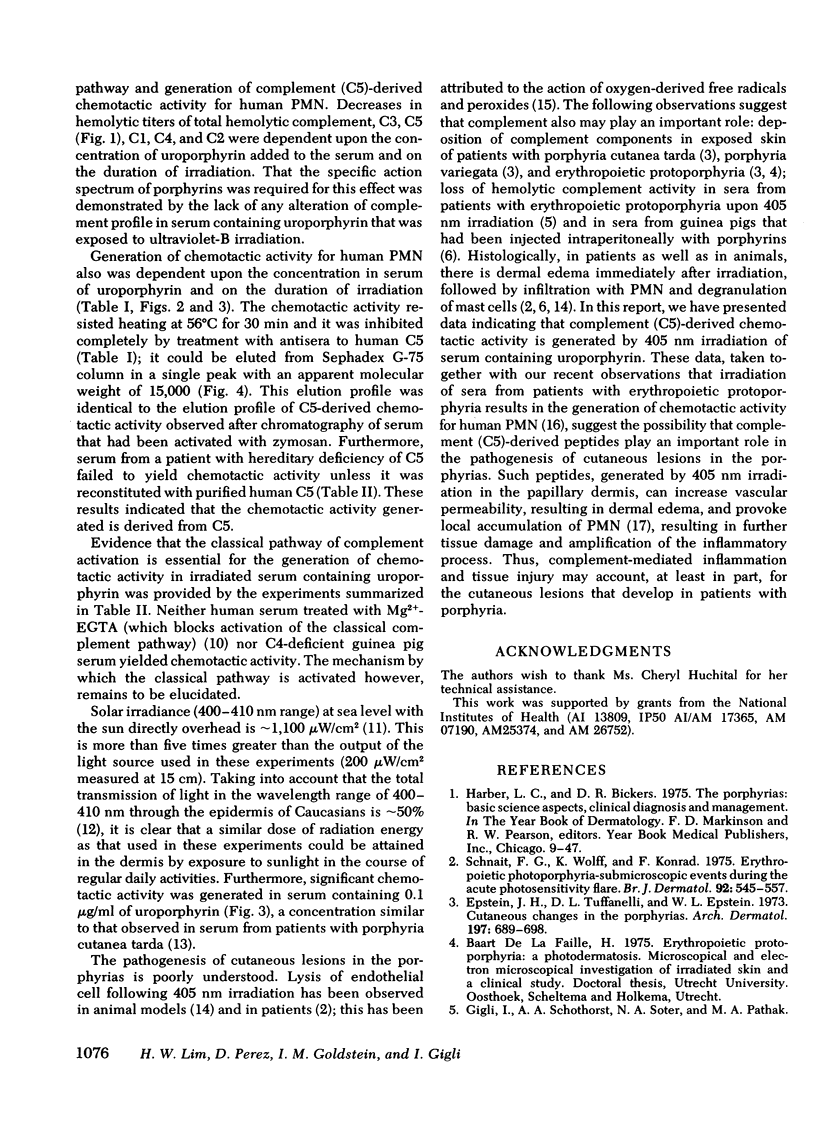
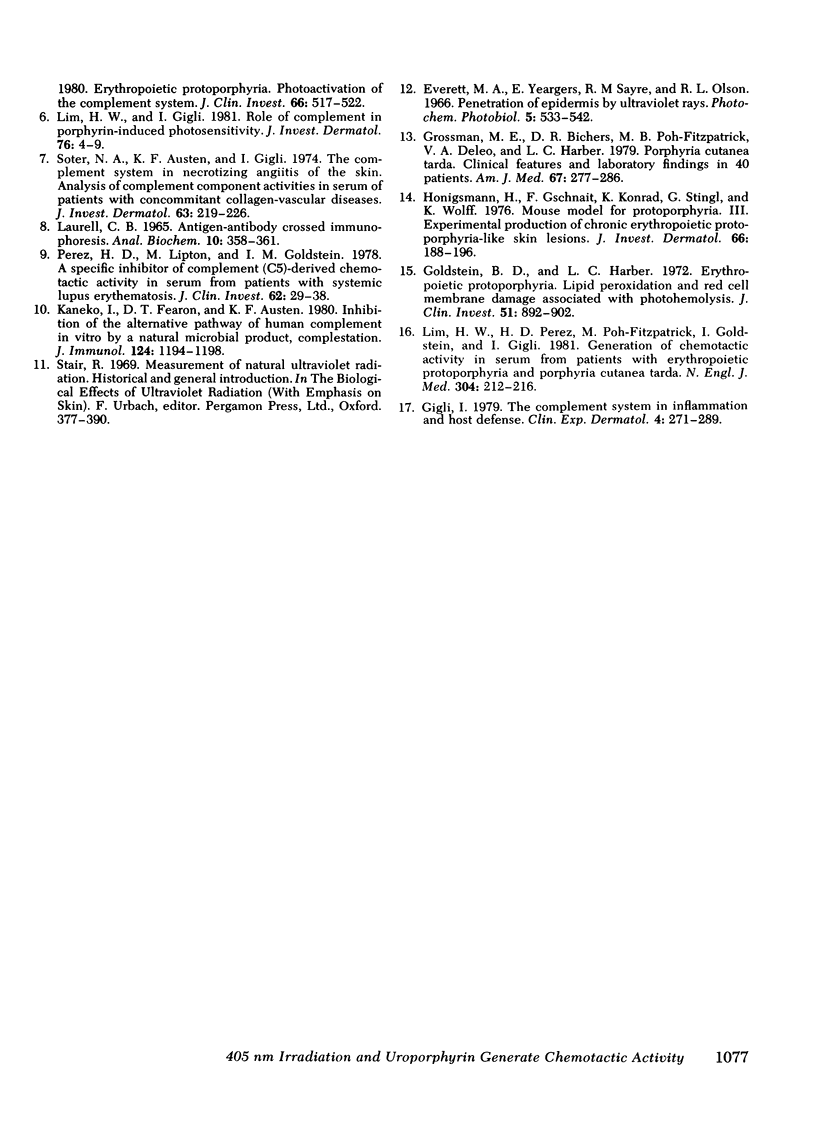
Selected References
These references are in PubMed. This may not be the complete list of references from this article.
- Epstein J. H., Tuffanelli D. L., Epstein W. L. Cutaneous changes in the porphyrias. A microscopic study. Arch Dermatol. 1973 May;107(5):689–698. [PubMed] [Google Scholar]
- Everett M. A., Yeargers E., Sayre R. M., Olson R. L. Penetration of epidermis by ultraviolet rays. Photochem Photobiol. 1966 Jul;5(7):533–542. doi: 10.1111/j.1751-1097.1966.tb09843.x. [DOI] [PubMed] [Google Scholar]
- Gigli I. Prosser White Oration 1978. The complement system in inflammation and host defence. Clin Exp Dermatol. 1979 Sep;4(3):271–289. doi: 10.1111/j.1365-2230.1979.tb02640.x. [DOI] [PubMed] [Google Scholar]
- Gigli I., Schothorst A. A., Soter N. A., Pathak M. A. Erythropoietic protoporphyria. Photoactivation of the complement system. J Clin Invest. 1980 Sep;66(3):517–522. doi: 10.1172/JCI109883. [DOI] [PMC free article] [PubMed] [Google Scholar]
- Goldstein B. D., Harber L. C. Erythropoietic protoporphyria: lipid peroxidation and red cell membrane damage associated with photohemolysis. J Clin Invest. 1972 Apr;51(4):892–902. doi: 10.1172/JCI106884. [DOI] [PMC free article] [PubMed] [Google Scholar]
- Grossman M. E., Bickers D. R., Poh-Fitzpatrick M. B., Deleo V. A., Harber L. C. Porphyria cutanea tarda. Clinical features and laboratory findings in 40 patients. Am J Med. 1979 Aug;67(2):277–286. doi: 10.1016/0002-9343(79)90403-0. [DOI] [PubMed] [Google Scholar]
- Hönigsmann H., Gschnait F., Konrad K., Stingi G., Wolff K. Mouse model for protoporphyria. III. Experimental production of chronic erythropoietic protoporphyria-like skin lesions. J Invest Dermatol. 1976 Mar;66(3):188–195. doi: 10.1111/1523-1747.ep12481938. [DOI] [PubMed] [Google Scholar]
- Kaneko I., Fearon D. T., Austen K. F. Inhibition of the alternative pathway of human complement in vitro by a natural microbial product, complestatin. J Immunol. 1980 Mar;124(3):1194–1198. [PubMed] [Google Scholar]
- LAURELL C. B. ANTIGEN-ANTIBODY CROSSED ELECTROPHORESIS. Anal Biochem. 1965 Feb;10:358–361. doi: 10.1016/0003-2697(65)90278-2. [DOI] [PubMed] [Google Scholar]
- Lim H. W., Gigli I. Role of complement in porphyrin-induced photosensitivity. J Invest Dermatol. 1981 Jan;76(1):4–9. doi: 10.1111/1523-1747.ep12524423. [DOI] [PubMed] [Google Scholar]
- Lim H. W., Perez H. D., Poh-Fitzpatrick M., Goldstein I. M., Gigli I. Generation of chemotactic activity in serum from patients with erythropoietic protoporphyria and porphyria cutanea tarda. N Engl J Med. 1981 Jan 22;304(4):212–216. doi: 10.1056/NEJM198101223040406. [DOI] [PubMed] [Google Scholar]
- Perez H. D., Lipton M., Goldstein I. M. A specific inhibitor of complement (C5)-derived chemotactic activity in serum from patients with systemic lupus erythematosus. J Clin Invest. 1978 Jul;62(1):29–38. doi: 10.1172/JCI109110. [DOI] [PMC free article] [PubMed] [Google Scholar]
- Schnait F. G., Wolff K., Konrad K. Erythropoietic protoprophyria--submicroscopic events during the acute photosensitivity flare. Br J Dermatol. 1975 May;92(5):545–557. doi: 10.1111/j.1365-2133.1975.tb03123.x. [DOI] [PubMed] [Google Scholar]
- Soter N. A., Austen K. F., Gigli I. The complement system in necrotizing angiitis of the skin. Analysis of complement component activities in serum of patients with concomitant collagen-vascular diseases. J Invest Dermatol. 1974 Aug;63(2):219–226. doi: 10.1111/1523-1747.ep12679439. [DOI] [PubMed] [Google Scholar]


